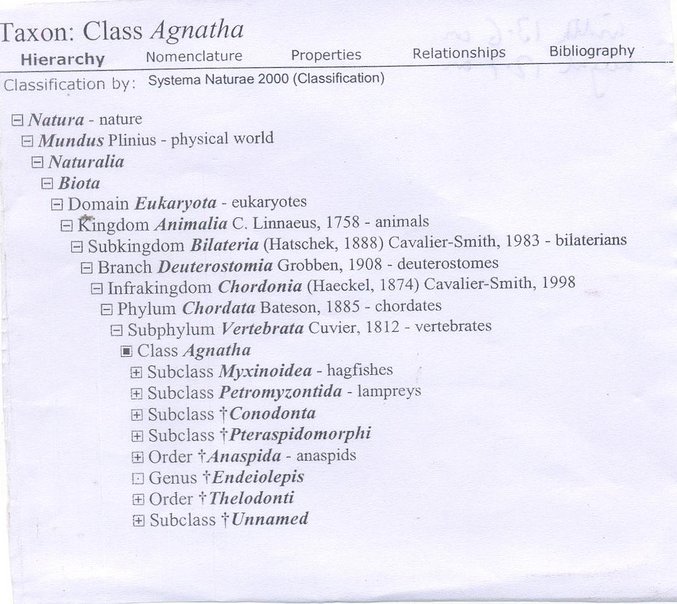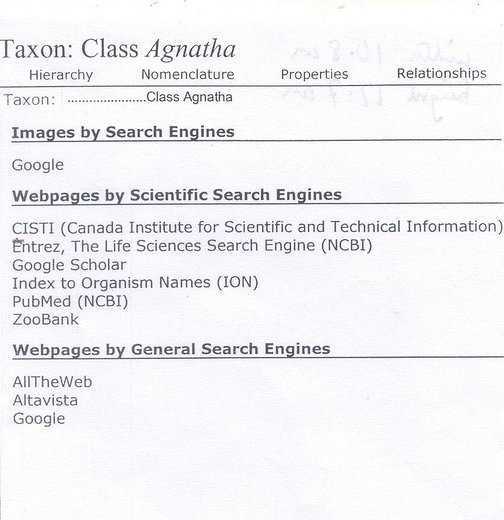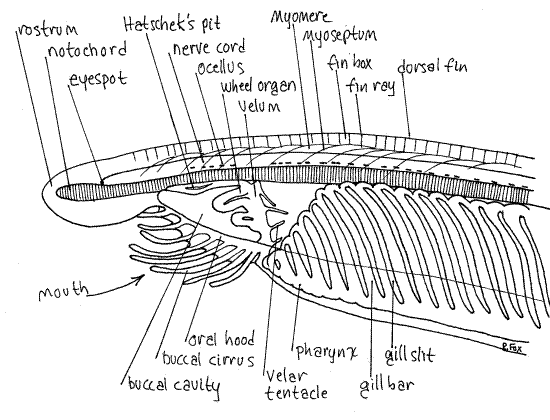Animals (continued)
2. Chordates
Vertebrates are traditionally divided into five classes: FISH, AMBHIBIANS, REPTILES, BIRDS and MAMMALS. All except the first are classified as land vertebrates. On this page we are concerned with fish and lower marine animals classified as chordates. The progression from lower chordates to tetrapods is as in the following cladogram:
This is a simplified form of the classification given in the tolweb pages. The blog article The Tree of Life Web Project at blogspot explains how to use the tolweb site and also points out its limitations.
The taxonomy requires some further explanation. Firstly, extinct forms such as the Yunnanozoon and the Pikaia are omitted. The oldest fossil Chordates are of Cambrian age. Of these, we put in a few lines about only one.
Pikaia gracilens is an extinct animal found near Mount Pika in the Burgess Shale. It was discovered by Charles Walcott in 1911 and classified as a polychaete worm. In 1979, palaeontologist Simon Conway Morris placed P. gracilens in the chordates, because it seemed to have a very primitive proto-notochord.
Further palaeontological information is found in Chapter 12 of "The Earth through Time" by Harold L. Levin. The second page of the on-line chapter mentions the Pikaia.
The craniata, or craniates, include all animals having a skull (cranium), be it cartilagineous or bony. They fall into two major clades, the hagfishes and the vertebrata. Until recently, the hagfishes were regarded as a sister group of the lampreys. Dumeril (1806) grouped hagfishes and lampreys in the taxon Cyclostomi.
| - | - Hyperotreti (hagfish) | |||
| - | - Cyclostomi - | -| | ||
| <--- | | | - | - Hyperoartia (lampreys) | |
| | | ||||
| - | --------------- | -- | - Gnathostomata (jawed vertebrates) |
Cope (1889) coined the term Agnatha (jawless) for a group that included the cyclostomes and a number of fossil groups in which jaws could not be observed. S. Løvtrup [The Phylogeny of Vertebrata. Wiley, New York (1977)], however, showed that the characteristics shared uniquely by lampreys and gnathostomes largely outnumber those shared uniquely by hagfishes and lampreys. Since only gnathostomes possess vertebral elements, and since hagfishes, lampreys and the gnathostomes all posses a skull, Janvier (1978) proposed to use Linnaeus' initial names Vertebrata and Craniata for the two nested taxa defined by these respective characteristics:
| - | -------------- | -- | - Hyperotreti (hagfish) | |
| Craniata - | | | |||
| | | - | - Hyperartia (lampreys) | ||
| - | - Vertebrata - | -| | ||
| - | - Gnathostomata (jawed vertebrates) |
If we go through the tolweb author P. Janvier's list of publications, we find a paper [Mol.Biol. Evol. 2000 Apr; 17(4) 519-29, No. 33 on the PubMed list] in which he mentions that the question of whether or not agnatha forms a clade is still unresolved. The first few lines of the on-line abstract read:
"There are two competing theories about the interrelationships of craniates: the cyclostome theory assumes that lampreys and hagfishes are a clade, whose sister group is the jawed vertebrates (gnathostomes); the vertebrate theory assumes that lampreys and gnathostomes are a clade, the vertebrates, whose sister group is hagfishes."
The Taxonomicon lists agnatha as a class; images of the relevant pages are given below.
 |

|
The image on the left is from the page taxonomicon.taxonomy.nl/TaxonTree.aspx?id=41625 of The Taxonomicon, accessed on 20 Nov 09. That on the right is the page obtained by clicking on "Links" on the second line [Hierarchy|Nomenclature|Properties|... etc.]. The Google Scholar list obtained from here contains the paper "Molecular Phylogeny of Early Vertebrates" from oxfordjournals.org, which also discusses this question. Referring to the Google Directory Page on Taxonomy, we see that tolweb, which was created in 1995, is third in Google PageRank order, while Taxonomicon, created in 2004, is 22nd. The National Geographic news article "Is it Time to revise the System of Scientific Naming?" (4 Dec 01) is 15th in the list. It discusses classification of hominoids and points out that morphological distinctions are not necessarily proof of evolutionary relatedness. (The Google Directory page was accessed on 23 Nov 09.)
| Contents of This Page |
|
2.1 Anatomy of primitive fish-like chordates
The following images illustrate some points of the anatomy of cephalochordata (amphioxus), hyperotreti (hagfishes), and hyperarteria (lampreys).
(I) CRANIATE SKULLS
Source:http://tolweb.org/Craniata/14326
(II) AMPHIOXUS ANTERIOR END

Source:http://webs.lander.edu/rsfox/invertebrates/branchiostoma.html
(III) VERTEBRAL COLUMNS

Source:http://tolweb.org/Vertebrata/14829
2.2 Tunicates
The best known of the tunicates are Sea Squirts which belong to the class Ascidiacea. The tunicate classes are:
Ascidiacea| Thaliacea| Appendicularia| Sorberacea
The nature and relationships of ascidians were not understood for a long time, although they were known even to Aristotle. Early authors, including Carl Linnaeus, placed colonial ascidians in zoophytes, a compound group that contained many unrelated taxa, while solitary ascidians were regarded as molluscs. In 1816 J. C. Savigny first recognised the common nature of solitary and colonial ascideans, as well as some pelagic forms, and in the same year J. B. Lamarck created the group Tunicata. Other authors still treated this group as a class of molluscs. From 1867 to 1872 the Russian embyologist A. Kowalewsky published several works on larval development and morphological characteristics of ascidians and was the first to recognise the close relationship between ascidians and chordates. Kowalewsky showed that the development of ascidians was similar to that of lancelets (cephalochordata).
Darwin suggested in 1871, in The Descent of Man Chapter 6, that ascidians and vertebrates diverged from a common ancestor, with, as he put it, "... one branch retrograding in development and producing the present class of Ascidaias, the other rising to the crown and summit of the animal kingdom by giving birth to Vertebrata."
The development of sea squirts from the enbryo to adult stage is described at
www.microscopy-uk.org.uk/mag/artaug98/tuni1.html
Images of all kinds of ascidians can be found at
In December 2002 a consortium of researchers led by the U. S. Department of Energy's Joint Genome Institute (JGI) and other institutions in the United Stats and Japan published a report on the analysis of the genome of the common sea squirt Ciona intestinalis (JGI, 12 Dec 2002). The analysis revealed a number of vertebrate-like genes, including complement, lectin, and Toll-like receptor genes. Ciona, however, uses a protein called haemocyanin, rather than the usual haemoglobin, to transport oxygen through its bloodstream.
The strongest evidence that tunicates are closely related to echinoderms is perhaps that given in the wikipedia article on Tunicates (section: Classification). The last paragraph is quoted below:
Sea squirts have become a testing ground in the controversy about the extent to which cross-species gene transfer and hybridization have influenced animal evolution. In 1990, Donald I. Williamson of the University of Liverpool (U.K.) fertilised sea squirt (Ascidia mentula) eggs with sea urchin (Echinus esculentus) sperm resulting in fertile adults that resembled urchins,[1] but Michael W. Hart of Simon Fraser University failed to find sea-squirt DNA in tissue samples from the supposed hybrids.[2] Williamson claims to have repeated the experiment with sea urchin eggs and sea squirt sperm, producing sea urchin larvae which developed into squirt-like juveniles.[3] Michael Syvanen of the University of California has further suggested that sea squirts are themselves descended from a hybrid between a chordate and an ancestor of sea urchins.[4] Like Williamson's, this idea has not yet gained support from embryologists and invertebrate zoologists.
The references cited in this paragraph are:
2.3 Amphioxus
There are two families: Asymmetronidae and Branchiostomidae. Taxonomical information may be found at
http://animaldiversity.ummz.umich.edu/site/accounts/classification/Cephalochordata.html
The two images below illustrate the development of the amphioxus.


They are taken from Chapter 3 of "Textbook of Vertebrate Embryology" by N.N. Majumdar.
The amphioxus is a small marine animal, hardly 6 cm long. The males and females are separate. The egg (ovum) of the amphioxus, about 0.1 mm in diameter, has a cell membrane (ooleme) covered by a thin vitelline membrane (1st image). The sperm of the amphioxus is about 20 μm long and its head about 1 μm wide. For fertilisation, one sperm enters the egg.
The embryo of the amphioxus hatches when about 10 somites (thick blocks with narrow cavity inside) are formed. The embryo is now called a larva (2nd image). It is a minute creature, about 1 mm long. In about three months' time the larva becomes a young amphioxus.
2.4 Hagfishes and lampreys
| Hagfish | Lamprey |
 |
 |
| Image courtesy of Lewis and Clark Legacy 2001 | Image from Great Lakes Fishery Commision |
More information is available at the links below:
| Hagfish | Lamprey |
2.5 Chondrichthyes and actinoperygii
The jawed fishes are normally divided into three groups
Further classification is given in the table below:
| CLASS | SUBCLASS | Examples |
| Acanthodii* | Placodermi* | |
| Chondrichthyes | Elasmobranchi | sharks, skates, rays |
| Holocephali | Chimaera | |
| Osteichthyes | Actinopterygii | bony fish |
| Sarcopterygii | coelacanth, lungfish | |
| * extinct | ||
The Osteichthyes evolved in the late Silurian or early Devonian, while the Teleosts evolved in the Triassic period, much later than the first land vertebrates. The Chondrichthyes evolved in the early Silurian, but are cladistically unrelated to the land vertebrates. For this reason, Chondrichthyes and Actinopterigii have been relegated to a separate page. See
FISHES (to be created)
at this site.
2.6 Sarcopterygii
The Sarcopterygii (lobe finned fishes and terrestrial vertebrates) evolved in the late Silurian period (418 million years ago). There are three existing subclasses:
The cladogram from the tolweb page on Sarcopterygii, reproduced below, includes extinct classes.
| - | -- | ?- | Onychondriformes† | ||||
| | | |||||||
| | | -- | - | -- | - | -- | Coelacanthimorpha | |
| <-- | | | ||||||
| | | - | -- | Porolepimorpha† | ||||
| | | -- | - | -- | | | |||
| | | - | -- | Dipnoi | ||||
| | | |||||||
| | | - | -- | - | -- | Rhizodontimorpha† | ||
| | | | | ||||||
| - | -- | | | - | -- | Osteolepimorpha† | ||
| - | -- | | | |||||
| - | -- | Terrestrial Vertebrates |
[† = extinct]
Crossopterygians (coelacanths and lungfish) are bony fish with fleshy, lobe-paired fins, which are joined to the body by a single bone. The fins of crossopterygians differ from those of all other fishes in that each is borne on a fleshy, lobelike scaly stalk extending fom the body. Pectoral and pelvic fins have articulations resembling those of tetrapod limbs. These fins have evolved into the legs of the fist land vertebrates (amphibians).
Fossils of the coelacanth were discovered by naturalist Louis Agassiz (1807-1873, who also proposed the Ice Age) in 1836. Some 15 species of fossilised coelacanth, dating from 400 to 66 mya (million years ago) have been discovered since then, and they were thought to be extinct until a living specimen was caught off South Africa in 1938. It was examined by Marjorie Courtenay Latimer, the curator of a museum in the port town of East London, South Africa. Professor J.L.B. Smith of Rhodes University, Grahamstown, identified the fish immediately as a coelacanth. There are two living species: Latimeria chalumnae and Latimeria menadoensis (first discovered in Indonesia in 1997).
An acount of the discovery of the coelacanth is found at dinofish.com.
A description of the anatomy of the coelacanth is found at
http://www.pbs.org/wgbh/nova/fish/anatomy.html
The two living species of coelacanth, along with six living species of lungfishes, have paired lobe fins projecting from the body on stalks. (See diagram below.)

They even move their paired fins much like land animals move their limbs: the right pectoral fin moves in conjunction with the left pelvic fin for example. They have no fully formed vertebrae, but an elastic and fibrous notochord filled with oil. They are ovoviviparous (eggs fertilised internally and retained in the mother's oviduct so that the young are born alive) and their eggs are among the largest vertebrate eggs known. At the time of birth, the pups are about a foot long.
Lungfish evolved in the early Devonian times (about 400 mya). The South American lungfish (Lepidosiren paradoxa) was the first one to be described, by Leopold J.F.J. Fitzinger in 1837, after it was discovered and collected from the Amazon River by Johann Natterer (cf. www.answers.com/topic/lungfish). The first African lungfish was described by British anatomist Sir Richard Owen (1804 - 1892). The Australian lungfish was well known in the 1800s, but its importance to science was first recognised by Australian Museum Director General Gerard Krefft in 1870. The South American and African species possess two lungs, while the Australian (Queenland) lungfish possesses only one. A list of all living lungfish species is given at
http://www.fishbase.org/ComNames/CommonNameSearchList.php?CommonName=Lungfish
The image below shows the lungs of the Protopterus dolloi.

Source: wikipedia File:Lungs_of_Protopterus_dolloi
All lungfishes demonstrate an uninterrupted cartilagenous notochord an an extensively developed palatal dentition. Basal lungfish groups may retain marginal teeth and an ossified braincase, but derived lungfish groups, including all modern species,show a significant reduction in the marginal bones and a cartilagenous braincase. Modern lungfish all have an elongate body with fleshy paired pectoral and pelvic fins and a single unpaired caudal fin.
During the Devonian Period, traditionally called the "Age of Fishes," semi-aquatic and terrestrial tracheophytes (vascular plants) emerged and diversified. Terrestrial invertebrates responded to floral changes. This set the stage for the evolution of tetrapods. Detailed information is given at www.devoniantimes.org.
Tentative version created: 20 Dec 09
----- BACK TO FIRST PAGE | NEXT PAGE -----